Automobile and Parts
New Energy Vehicle Parts Construction Project of Baicheng City
1. Introduction to the Project
1.1 Project background
1.1.1 Product introduction
New energy vehicles refer to vehicles which adopt new power system and are driven by new energy completely or mainly, including plug-in hybrid electric vehicles (including extended range) vehicles, pure electric vehicles and fuel cell electric vehicles. New energy vehicles parts include power battery, driving motor, electric control system, charging equipment and other key parts.
The project will integrate and upgrade the existing local automotive parts manufacturers in Baicheng, build a new energy vehicles parts production base, and guide enterprises to connect the production and research and development of new energy vehicles parts.
1.1.2 Market prospect
1. Status of new energy vehicle industry development in China
As an important branch of the automobile industry, the new energy vehicles industry has welcomed unprecedented development opportunities globally in recent years. With the enhancement of environmental protection awareness and the continuous progress of technology, the new energy vehicle gradually becomes the development direction of the automobile industry in the future due to its characteristics of low carbon, environmental protection and energy conservation. Especially in China, under the strong support of the government, the new energy vehicles industry has made remarkable development achievements. From 2016 to 2020, the growth rate of production and sales of new energy vehicles in China was relatively stable and maintained a high-speed growth since 2021. In 2023, the production and sales of new energy vehicles reached 9.587 million and 9.495 million respectively, maintaining a significant year-on-year growth. The penetration rate increased to 31.55%, an increase of 5.95% compared with 2022, indicating rapid growth in the entire new energy vehicle sector. The production and sales volume of new energy vehicles in China ranks first in the world, and has become an important driving force for the electric transformation of the global automobile industry.
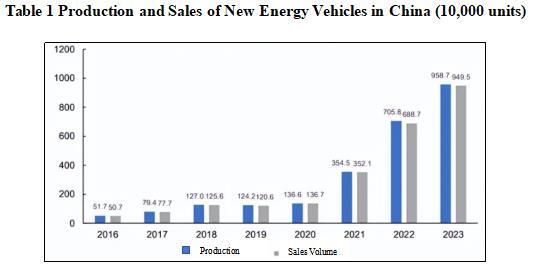
The new energy vehicle industry is changing from policy-driven to market-driven, and new energy passenger vehicles have become the main growth force in the new energy vehicle sales market. The production and sales of new energy passenger vehicles in China increased from 345,000 and 337,000 in 2016 to 9,121,900 and 9,047,900 in 2023, with a compound annual growth rate of 59.65% and 60.07% respectively. In 2023, the production and sales volume of new energy passenger vehicles increased by 35.83% and 38.17% respectively compared with that in 2022, and the sales volume of new energy passenger vehicles accounted for 95.29%.
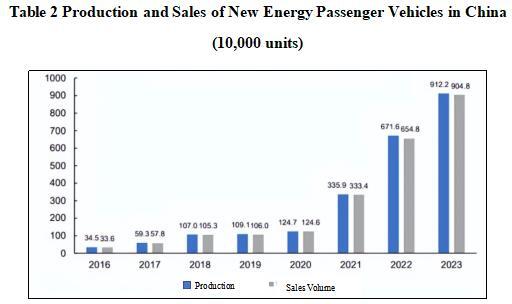
In terms of new energy vehicle types, pure electric still occupies the leading position in the market. In 2023, the sales volume of pure electric vehicles increased to 6.685 million vehicles, with a year-on-year growth of 24.61%, accounting for 70.41% of the sales volume of new energy vehicles; The sales volume of plug-in hybrid electric vehicles (including extended range) was 2,804,000, with a year-on-year growth of 84.68%, accounting for 29.53% of the sales volume of new energy vehicles. Fuel cell vehicles are in the initial stage of industrialization development. In 2023, the sales volume is only more than 5,800 units, accounting for a very low proportion.
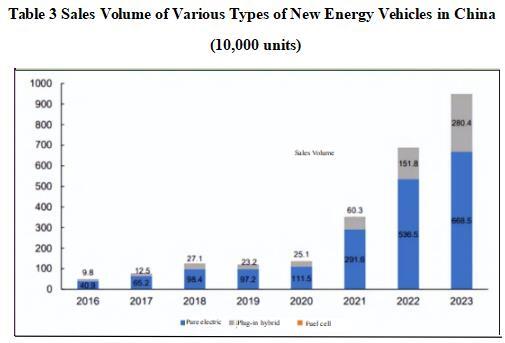
Currently, China's new energy vehicles are also in a continuous penetration stage. In recent years, the penetration rate of new energy vehicles has increased from 1.81% in 2016 to 31.55% in 2023, especially in 2021-2023, the penetration rate has increased by 18.15 percentage points. According to the “Action Plan for Carbon Dioxide Peaking Before 2030”, the proportion of new energy and clean energy-powered vehicles will reach about 40% in 2030. In 2023, the sales volume of new energy vehicles in China was only 31.55% of the total sales volume of domestic automobiles in the same period, with huge market space.
Overall, relying on the continuously developed and mature industrial chain and technology, China's new energy vehicle manufacturers are likely to maintain or even enhance their position in the global market. However, it is noteworthy that the international mainstream automobile enterprises have announced long-term plans for electrification, clearly positioning China as the largest potential market for electrification. It is expected that competition in the new energy vehicle market will intensify in the future. In recent years, China's new energy vehicle market has experienced strong growth in both production and sales. Looking at the sales performance of Chinese new energy vehicle manufacturers/brands, many brands have seen positive growth in their sales figures. Specifically, in 2023, the top ten new energy vehicles sales enterprises in China were BYD, Tesla, GAC-Aion, Geely Auto, SAIC General Motors Wuling, Chang'an Auto, Li Auto, Great Wall Motors, NIO, and Leapmotor.
2. Prospect of new energy vehicle industry Development in China
With the improvement of environmental protection awareness and the promotion of policies, the scale of the new energy vehicle market is constantly expanding. Consumer awareness of new energy vehicles is also improving, and market demand will further increase. It is expected that in the coming years, new energy vehicles will maintain a high-speed growth trend and gradually replace traditional fuel vehicles and become the leading force in the automobile market. According to the China Association of Automobile Manufacturers' forecast, automobile sales in China will reach 30 million units by 2025.
With the continuous expansion of the new energy vehicle market, the demand for automotive parts also increases sharply. The popularity of new energy vehicles, especially the rapid growth of pure electric vehicles and hybrid electric vehicles, has greatly increased the demand for core parts such as batteries, motors and electronic control systems. At the same time, the trend of lightweight and intelligentization of new energy vehicles has also driven the demand growth of relevant components such as aluminum alloy, magnesium alloy and other lightweight materials as well as intelligent sensors, autonomous driving system and other components.
The development of new energy vehicle industry has promoted the technological innovation and industrial upgrading of automotive parts industry. In order to meet the requirements of new energy vehicles for high performance, high safety and high reliability, automotive parts enterprises continuously increase R&D investment and improve the technological content and added value of products. For example, in the field of batteries, the enterprises are committed to improving the energy density, cycle lifespan and safety of batteries; In the field of electric motor and electric control, enterprises pay attention to improving the efficiency of motor, reducing noise and vibration, etc. The high-speed growth of the new energy vehicles industry promotes the coordinated development of the automotive parts industry chain. On the one hand, the cooperation between the whole automobile enterprises and the parts enterprises is closer to jointly promote the R&D and production of new energy vehicles; On the other hand, the cooperation between parts and components enterprises is also increasingly strengthened, and the competitiveness of the whole industrial chain is improved by means of resource sharing and complementary advantages. In addition, with the globalization of the new energy vehicles market, multinational automotive parts enterprises have also increased their investment in China, further promoting the internationalization process of China's automotive parts industry. The government's support policy for the new energy vehicles industry also provides a strong guarantee for the growth of the automotive parts industry. In recent years, China has issued a series of policies and measures to encourage the development of new energy vehicles, including financial subsidies, tax preferences, charging facilities construction, etc. These policies not only reduce the purchase and use costs of new energy vehicles, but also promote the rapid development of the new energy vehicle market. At the same time, with the continuous expansion of the new energy vehicle market and the improvement of consumer awareness, the market environment has been also gradually optimized, providing a wider space for the growth of the automotive parts industry. With the continuous progress of the new energy vehicles technology and the continuous expansion of the market, the automotive parts industry will usher in a broader development prospect. On the one hand, the core components market of new energy vehicles, such as batteries, motors and electronic control systems, will continue to maintain a rapid growth trend; On the other hand, with the further development of lightweight and intelligent trend of new energy vehicles, relevant components such as lightweight materials, intelligent sensors and autonomous driving system will also welcome new development opportunities. Meanwhile, with the further integration and optimization of the global automobile industry chain, China's automotive parts industry is expected to occupy a more important position in the global market.
The high-speed growth of the new energy vehicles industry has brought new impetus to the growth of the automotive parts industry and promoted the rapid development and transformation and upgrading of the whole industry. In the future, with the continuous expansion of the new energy vehicles market and the continuous progress of the technology, the automotive parts industry will usher in a broader development prospect.
1.1.3 Technical analysis
The project will introduce new energy vehicle power battery, drive motor, electronic control system, charging equipment and other key parts and components of mature technology.
1.1.4 Advantageous conditions of project construction
(1) Policy advantages
According to the “New Energy Vehicle Industry Development Plan (2021-2035)”, the average power consumption of new pure electric passenger vehicles will be reduced to 12.0 kWh/100km by 2025, and the sales volume of new energy vehicles will reach about 20% of the total sales volume of new vehicles. The key components technology supply system is constructed with three main aspects: power batteries and management systems, drive motors and power electronics, and connected and intelligent technologies. Efforts are being made to tackle technical challenges in advanced modular power battery and fuel cell systems, explore solutions for next-generation automotive motor drive systems, strengthen the development of key components and systems for intelligent connected vehicles, break through bottlenecks in computing and control platforms, as well as hydrogen fuel cell vehicle application support technologies. These efforts aim to enhance the research and development capabilities of fundamental key technologies, advanced basic processes, core components, and key materials.
The “Action Plan for Carbon Dioxide Peaking Before 2030” proposes to promote the low-carbon transformation of transport equipment, vigorously promote new energy vehicles, gradually reducing the proportion of traditional fuel-powered vehicles in new vehicle production and sales as well as vehicle ownership, pushing for the electrification of urban public service vehicles, and promoting electric, hydrogen fuel, and liquefied natural gas-powered heavy-duty freight vehicles. Improve the electrification level of the railway system.
The “Notice of the Baicheng Municipal People's Government Office on Issuing the Work Plan for Vigorously Implementing the ‘One-Three-Three-Four’ High-Quality Development Strategy to Accelerate the Cluster Development of Baicheng's New Energy Industry” proposes to leverage Baicheng's strong industrial foundation and significant advantages of high concentration. The goal is to cultivate and build a new energy industry cluster with distinctive features, a complete supply chain, high-end branding, strong competitiveness, significant driving effects, and an increasingly prominent leading position. Efforts will focus on nurturing specialized, refined, and innovative enterprises, as well as high-tech companies, creating a hub for high-growth businesses, attracting top talent, becoming a hotspot for venture capital, and a source of technological innovation. The aim is to establish a national-level new energy industry cluster. By 2025, the city's new energy installed capacity will reach 20 million kilowatts, and the new energy industry production value will reach 40 billion yuan. A development trend characterized by a clearly defined cluster advantage, high development level, and complete industrial chain will have been initially formed in the new energy industry. By 2030, the city's new energy installed capacity will reach 40 million kilowatts, and the new energy industry production value will reach 80 billion yuan. A development pattern of the new energy industry, with a higher degree of clustering, stronger competitive strength, larger enterprise scale, and better technology commercialization, will be basically formed, significantly boosting regional development capabilities.
(2) Resource advantages
Clean energy resources: The wind energy resources within Baicheng's jurisdiction are among the most promising for development in Jilin Province. In the five counties (cities, districts) of Baicheng, the total wind power in the atmosphere can generate 207.6 billion kilowatt-hours of electricity annually, with an effective wind energy density ranging from 268 to 348 watts per square meter. Light resource belongs to Class II light resource area, with the annual average sunshine hours of 2,919.4 hours and the annual average solar radiation of more than 5,200 MJ/m2. In 2024, the development scale of new energy in the whole city is expected to reach 14.28 million kilowatts, accounting for 66.7% of the whole province. With the installed capacity exceeding 16 million kilowatts by the end of the year.
Water resources: The natural groundwater resources of Baicheng City are 2.079 billion cubic meters/year, and the surface water resources are 358 million cubic meters/year. The exploitable groundwater resources amount to 1.59 billion cubic meters/year, accounting for 76.5% of the natural groundwater resources.
Land resources: Baicheng City has 1,424, 384.63 hectares of cultivated land, 2,860.63 hectares of garden land, 293,977.50 hectares of forest land, 358,120.99 hectares of grassland, 107,214.36 hectares of wetland, 92,746.65 hectares of urban village and industrial and mining land, 46,706.57 hectares of land for transportation, and 133,299.50 hectares of land for water area and water conservancy facilities.
(3) Industrial advantages
Centering on promoting the cluster development of equipment manufacturing industry, Baicheng City gathers 28 enterprises such as Sany and Envision to form the integrated development of the whole industrial chain from complete machines to parts. The manufacturing of energy storage equipment has begun to take shape. The lead-carbon battery of Jidian Energy Valley and the anode material of Hao'an lithium battery have been put into production in succession. Electrochemical energy storage projects, including Shanghai Electric's vanadium redox flow batteries, Envision's lithium batteries, CSSC's lithium batteries, and Sungrow's sodium-ion batteries, are accelerating construction within the district. Lithium batteries are expected to be produced successively by the end of the year. The automotive equipment manufacturing sector supports traditional component enterprises such as Zhongyi Precision Forging and Jinshida in developing supporting products for new energy vehicles, facilitating their deep transformation and integration into the provincial automotive industry cluster.
There are many key automotive parts industries in Baicheng Economic Development Zone, including excellent automotive parts companies such as Parker Company, Amphenol Gold Stat Electronic Company and Hengwei Automotive parts Company. During the “14th Five-Year Plan” period, the Economic Development Zone encourages enterprises to increase investment in project construction and technology, seizing the favorable opportunity presented by the construction of the “Changchun-Baicheng” Hydrogen Energy Corridor in western Jilin. The focus will be on expanding the supporting capabilities for new energy vehicles and building four major production bases for automotive original lines, wiring harness assemblies, hinges, and vehicle body panels. Additionally, national-level laboratories and testing centers will be established.
(4) Talent advantages
Baicheng City is home to several higher education institutions, including Baicheng Normal University, Baicheng Medical College, and Baicheng Vocational and Technological College. The city is also actively introducing Baicheng Industrial Vocational and Technological College. Once established, the college plans to enroll over 2,000 undergraduates annually from within the province and across the country, with the goal of reaching a scale of 10,000 students within 4-5 years. At that time, together with Baicheng Normal University and Baicheng Medical College, a “University City” with nearly 50,000 teachers and students will be formed, which can provide professional technological talents for the project.
(5) Location advantages
Located at the junction of Horqin Grassland and Songnen Plain, Baicheng City is the only place for the western part of Heilongjiang Province and the eastern part of Inner Mongolia Autonomous Region to pass into central China. It is also one of the main hub cities of the fourth Eurasia Continental Bridge as planned by the United Nations Development Programme. Baicheng is also an important area for the “Westward Expansion” strategy under the national Changchun-Jilin-Tumen Strategy, a key region for the Harbin-Changchun urban agglomeration's radiating influence, and a crucial node city in the “Belt and Road” initiative's China-Mongolia-Russia economic corridor.
There are 4 main railway lines of Changchun-Baicheng, Siping-Qiqihar, Baicheng-Arxan, Tongliao-Ranghulu railways. For Changchun-Baicheng express rail, it takes 2 hours 38 minutes direct to the provincial capital Changchun; National Highway G302 (Hunchun-Arxan), National Highway G231 (Nenjiang-Shuangliao), Provincial Highway S211 (Jalaid Banner-Tuquan), and 13 other provincial-level highways connect the entire Baicheng region. The Hunchun-UlanHot, Shuangliao-Nenjiang, and Tieli-Horqin Right Middle Banner expressways form crucial intersections for efficient transportation. Da'an Port is the only water channel for direct trade with the Russian Far East region along the Nenjiang River. Baicheng Chang'an Airport has opened flights to Beijing, Shanghai, Tianjin, Shijiazhuang, Qingdao, Dalian and so on, and has constructed an efficient, convenient and optimized traffic network.
1.2 Contents and scale of project construction
The project covers an area of 40,000 square meters and a construction area of 45,000 square meters. The project involves the purchase of new energy vehicle parts production equipment and the construction of supporting facilities, including production workshops, warehouses, a research and development center, office building, and employee dormitories.
1.3 Total investment of the project and capital raising
1.3.1 Total investment of the project
The total investment of the Project is 2,000 million yuan, including construction investment of 1,600 million yuan and current funds of 400 million yuan.
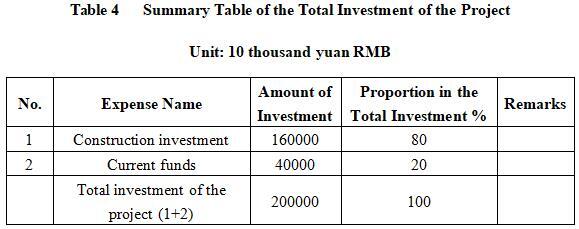
1.3.2 Capital raising
Self-funded by enterprises
1.4 Financial analysis and social evaluation
1.4.1 Main financial indexes
After the project reaches the production capacity, its annual sales income will be 2300 million yuan, its profit will be 350 million yuan, its investment payback period will be 8 years (after the tax, including the construction period of 2 years) and its investment profit rate will be 17.50%.
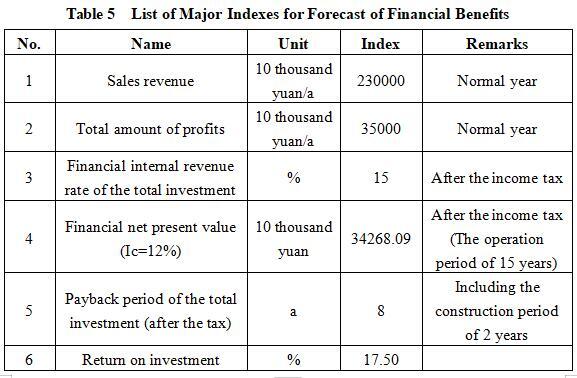
Note: “10 thousand yuan” in the table is in RMB.
1.4.2 Social evaluation
The construction of the project will accelerate the innovation and development of the core parts base of Baicheng new energy vehicles, which will help Baicheng new energy vehicle industry form a complete industrial chain, promote industrial upgrading and drive the development of downstream industries. Meanwhile, in the aspects of environmental protection and energy conservation, the wind power resource advantage of Baicheng City will be brought into full play, so that the new energy vehicles industry will develop more healthily, stably and sustainably.
1.5 Cooperative way
Joint venture, cooperation, sole proprietorship, other ways are negotiable.
1.6 What to be invested by the foreign party
Funding, other ways are negotiable.
1.7 Construction site of the project
Baicheng Economic Development Zone.
1.8 Progress of the project
Foreign investment attraction.
2. Introduction to the Partner
2.1 Basic information
Name: Baicheng Economic Development Zone Investment Promotion Bureau
Address: No. 88 Xingfu South Street, Baicheng City
2.2 Overview
Baicheng City is located in the northwest of Jilin Province, in the west of Nenjiang Plain and in the east of Horqin Grassland. Longitude 121 degrees 38 seconds to 124 degrees 22 minutes east, latitude 44 degrees 13 minutes 57 seconds north to 46 degrees 18 minutes. The total area is 26,000 square kilometers. The total population is 2.032 million. Currently, it has jurisdiction over one district (Taobei District), two counties (Tongyu County, Zhenlai County), two cities (Taonan City, Da'an City), three provincial-level development zones (Baicheng Economic Development Zone, Da'an Economic Development Zone, Chaganhot Tourism Economic Development Zone), five industrial concentration zones (Baicheng Industrial Park, Taobei, Tongyu, Zhenlai and Taonan Industrial Concentration Zone).
Baicheng Economic Development Zone was established in February 1998 with the approval of Jilin Provincial Government. It is the first provincial-level development zone in Baicheng Urban, located in the southwest of the city and inlaid in the exit zone of Taonan-Baicheng Economic Corridor. In 2010, the development zone embarked on a second-phase expansion, increasing its area to 171 square kilometers. It now governs three subdistricts-Xingfu, Baoping, and Xijiao-along with 14 administrative villages, 9 communities, and a population of 130,000. After more than 20 years of construction and development, it has continuously consolidated the pillar industries, optimized the investment environment, and has always been committed to expanding the commercial logistics, optimizing the manufacturing industry and strengthening the cultural industry. The comprehensive economic strength has been significantly enhanced, the social undertakings have made overall progress, the development environment has been increasingly optimized, and the carrying capacity has been further enhanced. It has become the western ecological new city of Baicheng, with the strongest economic strength, the best living environment, and the most active commercial and logistics activities. The area continues to release the power of vigorous development.
2.3 Contact method
Postal code: 137000
Contact Person: Sun Zhonggang
Tel: +86-436-3561069
+86-15904363335
Email: 1191340504@qq.com
Contact method of the city (prefecture) where the project is located:
City (Prefecture) Contact Person: Xu Zengchun
Tel: +86-436-3203010
+86-13894682986
Fax: +86-436-3224565
Email: bcjhj07@126.com


